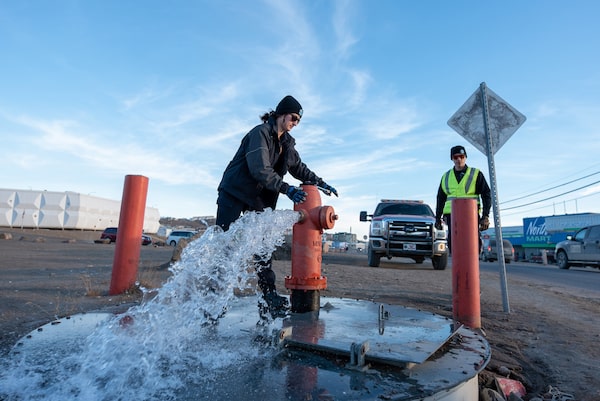
Members of the Iqaluit Fire Department in Nunavut assist with flushing the city's water pipes on Oct. 27, 2021. The City says it's investigating after receiving more than 20 complaints from residents who say they smell fuel in their tap water again.Dustin Patar/The Canadian Press
Iqaluit resident Kinguatsiaq Kinguatsiaq says he smelled fuel in his water a couple of days ago but assumed it must be something else.
“I figured I was wrong because I thought the situation had been resolved,” he said. “This morning I really noticed it when I was running my tap water. It was strong.”
The City of Iqaluit said in a statement Friday that trace amounts of fuel were detected in the Nunavut capital’s water supply earlier in the week, just over a month after a do-not-consume order on the city’s water was lifted.
Iqaluit’s some 8,000 people spent nearly two months under the order last fall after fuel was found in the water.
Mr. Kinguatsiaq said he’s concerned about his children drinking the water. No one in his family got sick, but both he and his son had bad headaches.
“The city should be really reliable for this because it’s risking my health and other people’s. Our trust is on them,” he said. “They could have resolved this when it happened the first time.”
With temperatures in the minus 30s, some residents have started drilling holes in the ice at the Sylvia Grinnell River outside of the city to get water.
Neither the city nor Nunavut’s health department has said the tap water is unsafe to drink.
In a post on Twitter, Mayor Kenny Bell thanked people for reporting the fuel smell and tried to reassure residents.
“The scan unit that is testing our treated water leaving the treatment facility for hydrocarbons is still testing well below Canadian national standards,” he wrote.
“We know some people smell it before detectable limits so calls to the city to let them know are important.”
The city previously said the source of the fuel contamination last fall came from a historic underground fuel tank, which was dug up shortly after the do-not-consume order was put in place.
The city said an initial review of data from its real-time monitoring station this week indicates fuel entered the water on Monday and Wednesday.
It said there have been no measurements above low-alarm thresholds, but the city is actively opening distribution valves to flush the water.
The city said in a release that it believes there may have been leftover hydrocarbons that got into the water supply again.
It is asking residents to remove aerators from their taps and to run the water on cold for 20 minutes before 6 p.m. Friday.
The city is also asking residents to report fuel smells to its water hotline so that staff can collect water samples.
Lizzie Kownirk, another Iqaluit resident, said she started smelling fuel in her tap water Thursday night.
Ms. Kownirk said she was happy about how quickly the city responded to new reports of fuel in the water. “The city called me that they were going to look into it and get water samples from my building. They said they would get back to me with the results.”
Ms. Kownirk also said she trusts the city and felt reassured, but still doesn’t want to drink the water as long as it smells like fuel.
Workers can’t enter people’s homes to test the tap water, however, because the territory is still under a COVID-19 lockdown order.
Instead, samples are being taken at the nearest site to homes that report fuel smells.
“The City continues to pro-actively screen for petroleum hydrocarbons and [has] increased its weekly laboratory sampling efforts of water produced by the water treatment plant and throughout the distribution system,” the city said in the release.
Our Morning Update and Evening Update newsletters are written by Globe editors, giving you a concise summary of the day’s most important headlines. Sign up today.